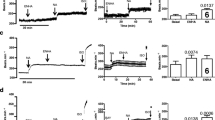Summary
Prenalterol, previously characterized as a functionally cardioselective partial β-adrenoceptor agonist, was shown to relax K+-elicited contractures in the uterine muscle from progesterone pretreated rats (pD 2 7.7) and to increase beating rate in the rat right atrium (pD 2 8.0) at about the same concentrations with maximal effects corresponding to 94 and 82% respectively of those of isoproterenol. Terbutaline, with equal maximal effects as isoproterenol, was 50 times more potent in the uterus (pD 2 7.8) than in the right atrium (pD 2 6.1). Both tissues displayed a high sensitivity to isoproterenol (pD 2 9.1 in both tisues) indicating large receptor reserves for the full agonist.
The maximal relaxing effect of prenalterol in the uterus was obtained at about a three-fold increase of the cyclic AMP content, which is similar to that obtained with isoproterenol at a corresponding relaxation.
The effects in the uterine muscle of all three agonists were mediated through β2-adrenoceptors since β2-adrenoceptor blockers (ICI 118,551 and IPS 339) antagonized the effects in concentrations which had only marginal effects on the atrial responses of the agonists. The β1-antagonists pafenolol and pamatolol in concentrations higher than those, which blocked the effects of the agonists on beating rate, were devoid of inhibitory effects in the uterus.
These results indicate that prenalterol possesses the ability to elicit a functional response by stimulation of either β1- or adrenoceptors provided that the tissue has a large spare receptor reserve for full agonists.
Similar content being viewed by others
References
Al-Jeboory AA, Marshall RJ (1978) Correlation between the effects of salbutamol on contractions and cyclic AMP content of isolated fastand slow-contracting muscles of the guinea pig. Naunyn-Schmiedeberg's Arch Pharmacol 305:201–206
Ariniego R, Waagstein F, Mombay B, Hjalmarson Å (1979) Haemodynamic effects of a new β1-receptor agonist in acute myocardial infarction. A useful antidote to unwanted cardiac effects of β-blocking agents. Br Heart J 42:139–146
Arunlakshana O, Schild HO (1959) Some quantitative uses of drug antagonists. Br J Pharmacol 14:48–58
Carlsson E, Dahlöf C-G, Hedberg A, Persson H, Tångstrand B (1977) Differentiation of cardiac chronotropic and inotropic effects of β-adrenoceptor agonists. Naunyn-Schmiedeberg's Arch Pharmacol 300:101–105
Carlsson E, Hedberg A, Mattsson H (1981) Classification and function of adrenoceptors. In: Delius W, Gerlach E, Grobecker H, Kübler W (eds) Catecholamines and the heart. Recent advances in experimental and clinical research. Springer, Berlin Heidelberg New York, pp 19–28
Cheng Y-G, Prusoff WH (1973) Relationship between the inhibition constant (Ki) and the concentration of inhibitor which causes a 50% inhibition (IC50) of an enzyme reaction. Biochem Pharmacol 22:3099–3108
Furchgott RF (1976) Postsynaptic adrenergic receptor mechanism in vascular smooth muscle. In: Vascular neuroeffector mechanisms, 2nd International Symposium Odense, 1975. Karger, Basel, pp 131–142
Hedberg A, Mattsson H (1981) Beta-adrenoceptor interaction of full and partial agonists in the cat heart and soleus muscle. J Pharmacol Exp Ther 219:798–808
Hedberg A, Mattsson H, Carlsson E (1980a) Prenalterol, a non-selective β-adrenoceptor ligand with absolute β1-selective partial agonist activity. J Pharm. Pharmacol 32:660–661
Hedberg A, Minneman KP, Molinoff PB (1980b) Differential distribution of beta-1 and beta-2 adrenergic receptors in cat and guineapig heart. J Pharmacol Exp Ther 212:503–508
Hedberg A, Carlsson E, Fellenius E, Lundgren B (1982) Cardiostimulatory effects of prenalterol, a beta-1-adrenoceptor partial agonist, in vivo and in vitro. Correlation between physiological effects and adenylate cyclase activity. Naunyn-Schmiedeberg's Arch Pharmacol 318:185–191
Imbs JL, Miesch F, Schwartz J, Velly J, Leclerc G, Mann A, Wermuth CG (1977) A potent new β2-adrenoceptor blocking agent. Br J Pharmacol 60:357–362
Johansson B (1979) Effects of atenolol, metoprolol and pamatolol on cardiac and vascular beta-adrenoceptors in the rat. J Cardiovasc Pharmacol 1:287–298
Johansson U, Waldeck B (1980) On the stereospecificity of the β2-adrenoceptor blocking properties of prenalterol. J Pharm Pharmacol 32:659–660
Johansson U, Waldeck B (1981) 308-3 mediating relaxation of the guinea-pig trachea: Experiments with prenalterol, a β2 adrenoceptor agonist. J Pharm Pharmacol 33:353–356
Kenakin TP, Beek D (1980) Is prenalterol (H 133/22) really a selective beta-1 adrenoceptor agonist? Tissue selectivity resulting from differences in stimulus-response relationships. J Pharmacol Exp Ther 213:406–413
Lowry OH, Rosebrough NJ, Farr AL, Randall RJ (1951) Protein measurement with the Folin phenol reagent. J Biol Chem 193:265–275
Lundgren B, Carlsson E, Ek L (1982) Pafenolol, I. β-Blocking potency and selectivity in in vivo and in vitro experiments. Acta Physiol Scand, Suppl 508 (Abstract) 44
Manders WT, Vatner SF, Brauwald E (1980) Cardio-selective betaadrenergic stimulation with prenalterol in the conscious dog. J Pharmacol Exp Ther 215:266–270
Minneman KP, Hedberg A, Molinoff PB (1979) Comparison of beta-adrenergic receptor subtypes in mammalian tissues. J Pharmacol Exp Ther 21:502–508
Nahorski SR (1981) Identification and significance of beta-adrenoceptor subtypes. Trends Pharmacol Sci 2:95–98
O'Donnell SR, Wanstall JC (1980) Evidence that ICI 118,551 is a potent, highly beta2-selective adrenoceptor antagonist and can be used to characterize beta-adrenoceptor populations in tissues. Life Sci 27:671–677
Rohm N, Wagner J, Schümann HJ (1980) The lack of pronounced preference of prenalterol for the beta-1-adrenoceptor subtype. Naunyn-Schmiedeberg's Arch Pharmacol 315:85–88
Rönn O, Graffner C, Johnsson G, Jordö L, Lundborg P, Wikstrand J (1979) Haemodynamic effects and pharmacokinetics of a new selective beta-1-adrenoceptor agonist, prenalterol, and its interaction with metoprolol in man. Eur J Clin Pharmacol 15:9–13
Scatchard G (1949) The attractions of proteins for small molecules and ions. Ann NY Acad Sci 51:660–672
Scott DHT, Arthur GR, Boyes RN, Scott DB (1979) Cardiovascular effects of prenalterol (133/22) in normal man. Br J Clin Pharmacol 7:365–370
Waldeck B (1977) Analysis of the β-receptor mediated effect on slow-contracting skeletal muscle in vitro. J Pharm Pharmacol 29:550–554
Wollenberger A, Ristau O, Schoffa G (1960) Eine einfache Technik der extrem schnellen Abkühlung größerer Gewebestücke. Pflügers Arch Ges Physiol 270:399–412
Author information
Authors and Affiliations
Rights and permissions
About this article
Cite this article
Mattsson, H., Andersson, T., Carlsson, E. et al. β1 and β2 Stimulatory effects of prenalterol. Naunyn-Schmiedeberg's Arch. Pharmacol. 321, 302–308 (1982). https://doi.org/10.1007/BF00498518
Received:
Accepted:
Issue Date:
DOI: https://doi.org/10.1007/BF00498518




